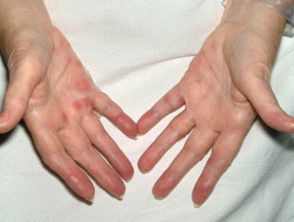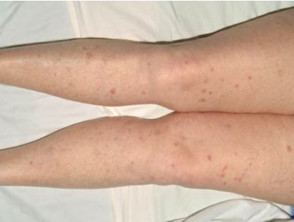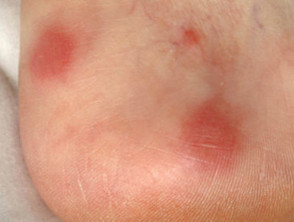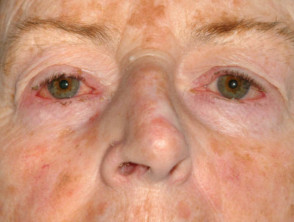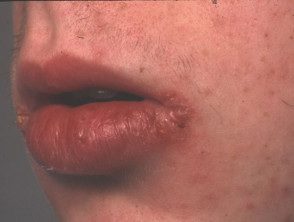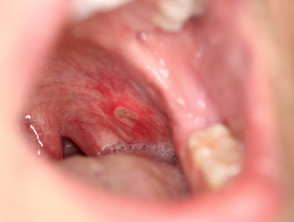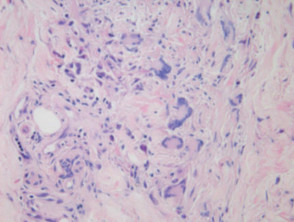What is Crohn disease?
Crohn disease is an inflammatory bowel disease that involves inflammation of the small intestine. This can cause pain, fever, constipation, diarrhoea and weight loss. Extraintestinal features are common in Crohn disease and include arthritis, skin problems, inflammation in the eyes or mouth, gallstones and kidney stones. Crohn disease affects about 1 in 300 Europeans and has peak onset in the teens and 20s.
When granulomatous lesions of Crohn disease involve sites other than the gastrointestinal tract, the disease is termed metastatic Crohn disease.
What are the clinical features of cutaneous Crohn disease?
Skin involvement or cutaneous Crohn disease occurs in about 40% of patients with Crohn disease.
Extension of intestinal Crohn disease
Skin tags, swelling (oedema), fissures and abscesses around the perineal and perianal region are common in patients with Crohn disease. Painful vulval or scrotal fissures and ulceration may occur. See DermNet's page on genital Crohn disease.
Metastatic Crohn disease
Metastatic granulomatous cutaneous Crohn disease may present as spots or plaques found on the trunk, arms and legs. Lesions tend to be asymmetrical and involve dermis and or subcutaneous tissue (panniculitis). They may be mildly itchy.
Cutaneous reactions to intestinal Crohn disease
In some cases, non-granulomatous skin disorders occur as a reaction to the intestinal disease. These include:
- Pyoderma gangrenosum
- Neutrophilic dermatosis / Sweet syndrome, typically with pustules
- Pyodermatitis-pyostomatitis vegetans, a purulent erosive dermatosis characterised by snail-track ulcers
- Erythema multiforme
- Erythema nodosum
- Acneform eruptions including nodulocystic acne, hidradenitis suppurativa and folliculitis
- Palisaded neutrophilic and granulomatous dermatitis
- Necrotizing and granulomatous small vessel vasculitis.
Occasionally, skin lesions may occur before any signs or symptoms of the intestinal disease.
Oral Crohn disease
Oral involvement occurs in 8-9% of Crohn disease and may include:
- Gingival or mucosal swelling
- Cobblestoning of the buccal mucosa
- Aphthous ulcers
- Mucosal tags
- Angular cheilitis
- Granulomatous cheilitis (persistent lip swelling).
Skin complications of Crohn disease
Secondary skin eruptions
Crohn disease affecting the gut may lead to malnutrition. Iron deficiency and vitamin deficiencies may present as skin or oral ulceration, persistent infections or pellagra.
Drugs prescribed for Crohn disease may also lead to adverse effects on the skin (drug eruptions).
How is Crohn skin disease diagnosed?
Skin biopsy of the lesion is performed. The histopathological finding of non-caseating granulomas similar to those found in intestinal Crohn disease supports the diagnosis of Crohn skin disease. In patients with no intestinal disease whose skin biopsy shows non-caseating granulomas, a thorough gastrointestinal history and systemic work-up should be performed.
The presence of anti-Saccharomyces cerevesiae (ASCA) antibodies in the blood are very suggestive of Crohn disease, with 60% sensitivity and 90% specificity.
* Granuloma on skin pathology
What is the treatment of Crohn skin disease?
Treatment for Crohn skin disease is palliative not curative.
Treatment of the intestinal manifestations usually improves the skin lesions. Treatment may include:
- Oral corticosteroids
- Intralesional steroids injected into or around skin lesions
- Antibiotics such as metronidazole and tetracycline, usually prescribed for weeks to months
- Methotrexate
- Azathioprine
- Sulfasalazine
- Anti-tumour necrosis factor (TNF) agents such as infliximab and adalimumab.
